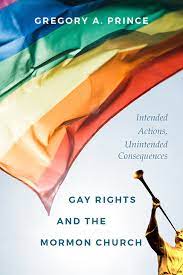
Intended Actions, Unintended Consequences
Gregory A Prince
University of Utah Press 2019
Prince’s introduction is a powerful accusation, “The LDS church has raised the stakes for LGBT children by condemning Homosexuality as evil, self-inflicted and impossible in post mortal existence. Thus opening the door to draconian behaviour by parents, peers and congregations. The numbers of homeless teenagers in Utah, many from Mormon homes is a jolting manifestation of such behaviour. Even more alarming is the rise in Utah teen suicides, tripling in the past decade and is the highest per capita in the US for this age demographic. A common theme indicated by the title’s sub heading is the harm created by the church’s stance, readers of the review will possibly be irritated by representations appearing only as a male issue, however, that accurately reflects the church’s rhetoric.
Prince demomnstrates how the church’s attitudes and actions were informed by now discredited assumptions about the nature of homosexuality. One of the church’s suggested cures encouraged men to act normally, marrying. Statistics showed that marriages of mixed orientation were very poor, revealing a 51% divorce rate with projections at the time suggesting this rate would increase. As the church became aware of the likely damage of such relationships it rescinded its advice through Gordon B Hinkley, First Presidency Counsellor in General Conference 1987, “Marriage should not be viewed as a therapeutic step to solve problems of homosexual inclinations or practices”.
The church proceeded under an outdated and unscientific view that Homosexuality was a lifestyle choice. In the 1960’s Apostle Mark E Peterson believed masturbation was an initial step to becoming gay, he made a number of incredibly amusing tips about avoiding the temptation among which was to use the bathroom with the door ajar, wearing many layers of clothing and raiding the fridge, better fat than gay. What a fridge magnet that would have made!
Prince chronicles the progress the church has made in changing its views and practices, readers today may experience strong emotions on hearing the details of various physical reparative therapy techniques. Rhetoric in particular from Apostle Boyd K Packer was biologically misinformed and temperature raising. Institutionally the church lead or sponsored a host of legal actions including opposition to Proposition 8 in order to prohibit same sex marriage, a leading adviser in this respect has been lawyer, Apostle Dallin H Oaks. One of the church’s big fears was being legally obliged to perform same sex marriages. Prince suggests this was baseless given the statements made by the proposers of any law permitting marriage because they safeguarded any religions refusal on the grounds of its beliefs. A more insidious motive proposed by Prince is a possible threat to tax exemption status by not allowing its public buildings to be used as marriage venues.
The anecdotes and personal stories towards the end of the book raise awareness of life in the church as LGBT likely to induce in equal measure a cocktail of empathy and anger. Due to the church’s insistence on homosexuality not being a natural phenomenon, young men strived earnestly to serve super diligent committed missions hoping their curse would be removed, yet disillusionment inevitably followed when no such miracle resulted.
Prince highlights the compassion showed by Seventy Marlin Jensen in a Californian special invitation meeting attended by over 100 members whilst he was on a stake conference assignment. A three minute window was strictly offered for speakers to share how they experienced life as a gay Mormon. Jensen cried and offered a personal apology. Dieter Uchtdorf also was singled out as a General Authority who offered a softer tone. Recently during general conference apostles have acknowledged the difficult challenges thrown out to people genetically. The church has increasingly engaged in dialogue with groups such as ‘Affirmation’ to find ways of not being seen as so oppositional. In a rare public statement the church declared its support for no discrimination for housing etc. In 2012 the church launched a web site Mormonsandgays.org to build more inclusiveness. (In preparing this article I tried visiting the site and was warned off re security issues)
A key question for reflection is how can God’s appointed leaders pronounce with authority Homosexuality as being unnatural in the 1960’s then in 2022 accept it as a genetic challenge? Is the obvious answer that Peterson and Packer, et al were not inspired?
Is it equally obvious that if the church promotes a way of thinking that is out of step with science and is unable to receive inspiration to counteract a false assumption, then the narrative of ‘Following the Prophet he knows the way’ is not as safe as we once thought?
If the authentic Jesus could not turn away from suffering during his mortal ministry, why is he apparently not willing to reveal ‘truth’ to his leaders, preventing them from supporting unwarranted electrocution conversion therapy.
Prince’s book is highly informative, the legal chapters were less appealing, it is full of interesting topics and historical development. Importantly it is current, I do not doubt that any reader will come away from its pages with a heart full of compassion, be willing to don their Sunday best clothes to join a supportive walk in downtown Salt Lake, hoisting a placard proclaiming ‘God loves everyone’. Evidence that members possess hearts turned to God and follow the Authentic Jesus, whereas Packer, Peterson & dare we say the incumbent President of BYU were metaphorically applying electrodes to male genitalia!